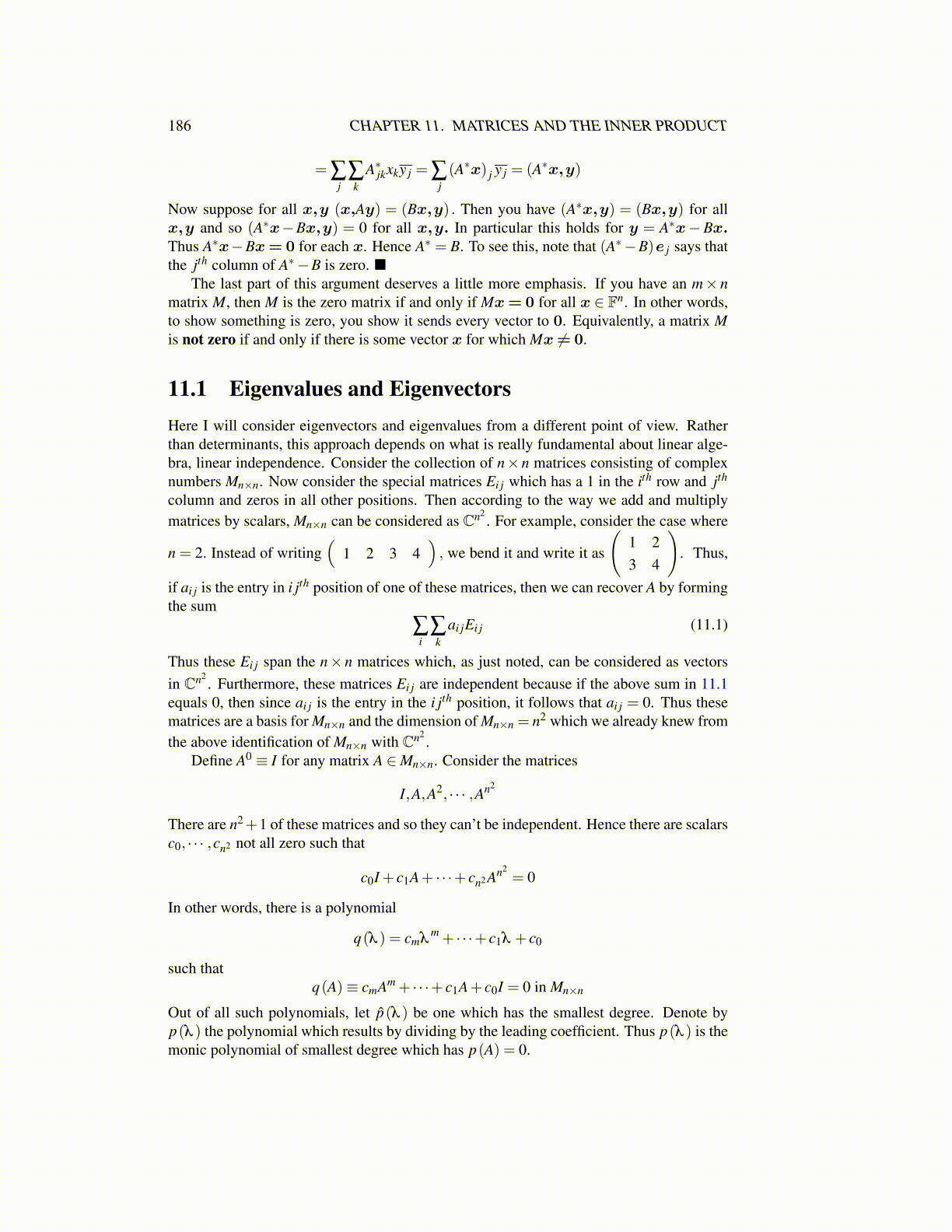
186 CHAPTER 11. MATRICES AND THE INNER PRODUCT
= ∑j∑k
A∗jkxky j = ∑j(A∗x) j y j = (A∗x,y)
Now suppose for all x,y (x,Ay) = (Bx,y) . Then you have (A∗x,y) = (Bx,y) for allx,y and so (A∗x−Bx,y) = 0 for all x,y. In particular this holds for y = A∗x−Bx.Thus A∗x−Bx= 0 for each x. Hence A∗ = B. To see this, note that (A∗−B)e j says thatthe jth column of A∗−B is zero. ■
The last part of this argument deserves a little more emphasis. If you have an m× nmatrix M, then M is the zero matrix if and only if Mx= 0 for all x ∈ Fn. In other words,to show something is zero, you show it sends every vector to 0. Equivalently, a matrix Mis not zero if and only if there is some vector x for which Mx ̸= 0.
11.1 Eigenvalues and EigenvectorsHere I will consider eigenvectors and eigenvalues from a different point of view. Ratherthan determinants, this approach depends on what is really fundamental about linear alge-bra, linear independence. Consider the collection of n×n matrices consisting of complexnumbers Mn×n. Now consider the special matrices Ei j which has a 1 in the ith row and jth
column and zeros in all other positions. Then according to the way we add and multiplymatrices by scalars, Mn×n can be considered as Cn2
. For example, consider the case where
n = 2. Instead of writing(
1 2 3 4), we bend it and write it as
(1 23 4
). Thus,
if ai j is the entry in i jth position of one of these matrices, then we can recover A by formingthe sum
∑i
∑k
ai jEi j (11.1)
Thus these Ei j span the n× n matrices which, as just noted, can be considered as vectorsin Cn2
. Furthermore, these matrices Ei j are independent because if the above sum in 11.1equals 0, then since ai j is the entry in the i jth position, it follows that ai j = 0. Thus thesematrices are a basis for Mn×n and the dimension of Mn×n = n2 which we already knew fromthe above identification of Mn×n with Cn2
.Define A0 ≡ I for any matrix A ∈Mn×n. Consider the matrices
I,A,A2, · · · ,An2
There are n2+1 of these matrices and so they can’t be independent. Hence there are scalarsc0, · · · ,cn2 not all zero such that
c0I + c1A+ · · ·+ cn2An2= 0
In other words, there is a polynomial
q(λ ) = cmλm + · · ·+ c1λ + c0
such thatq(A)≡ cmAm + · · ·+ c1A+ c0I = 0 in Mn×n
Out of all such polynomials, let p̂(λ ) be one which has the smallest degree. Denote byp(λ ) the polynomial which results by dividing by the leading coefficient. Thus p(λ ) is themonic polynomial of smallest degree which has p(A) = 0.